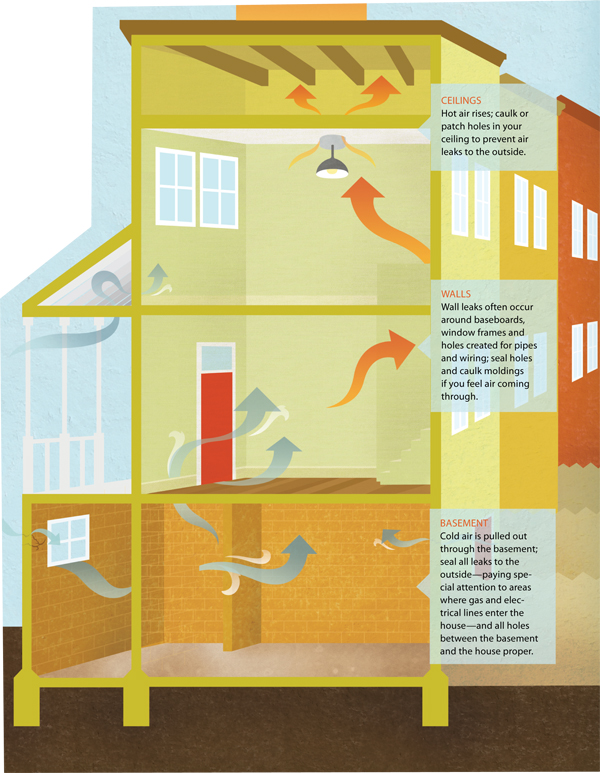
As part of Grid’s continuing effort to prepare you for the expiration of the PECO rate caps (see August’s cover story), we’re offering you this handy guide to weatherizing your home. The materials you’ll need for these projects, which cost between $5 and $20, are available at your local, independent hardware store. Implement these quick, inexpensive solutions, and you’ll save energy, decrease electric bills and free your house from drafts and leaks.
Thank you to the Energy Coordinating Agency (ecasavesenergy.org)
for allowing us to rework and republish their guide, and Rittenhouse Hardware (2001 Pine Street) for fact checking.

HOT WATER HEATER
Insulation Wrap
Water heater wraps are made of fiberglass insulation. Some pipe wrap insulation is still made with fiberglass, but you can also choose competing products made with foam or plastic.
Measure and Cut
1. Lay the heater wrap on the floor, fiberglass side down.
2. Measure the tank from the top down to the drain valve.
3. Measure jacket and cut any extra off the bottom. The top has a plastic flap.
4. Wrap the excess strip cut from bottom of jacket around water heater. Cut to fit exactly.
5. Using strip as a guide, cut width of jacket.
Tape Jacket
6. Clean and dry top of tank
7. Wrap extra insulation jacket around water heater. Tape across seam at top, middle and bottom of jacket.
8. Tape plastic flap to top of tank.
9. Tape seam from top to bottom.
10. Use duct tape to make two “suspenders,” which reach across top of tank and down six inches on each side.
11. Tape a “belt” of duct tape all the way around water heater across ends of suspenders.
12. Put another belt of tape around jacket above control box.
Final Cuts
13. Cut jacket away from pressure relief valve, burner box and controls.
14. If you have an electric water heater, cut open a flap for both access panels, and cover the top of the heater with extra insulation.

Temperature Control
Set your water heater temperature to make sure it’s not hotter than it has to be—you should be able to use your hot water without adding cold water.
Gas: Use the dial in the control box to turn the temperature of your water heater down to warm (or low).
Electric: An electric water heater has two temperature controls behind the access panels on the front. To lower the temperature, turn off electricity, take off access panels and turn down both controls. The top control should be five degrees higher than bottom one. We suggest 125 degrees for top and 120 degrees for bottom.

Furnance Filters
If you have heating vents, you have a hot air furnace and a furnace filter.
1.Check filter every month.
2. If filter is dirty, replace it with a new one of the same size.
3. Filters have arrows on the top side. Put new filter in with arrow pointing into furnace.
4. If old filter is reusable, clean it and put it back.

DOORS:
V-Seal
V-Seal weatherstripping helps create a tighter seal around windows and doors. It’s plastic with an adhesive backing on one half.
1. Clean doorframe. Wipe with all-purpose cleaner and dry.
2. Measure top of doorframe and cut a strip of V-Seal to fit exactly.
3. Fold strip along centerline into a “V” shape. Paper backing should face out.
4. Stick strip onto frame with folded edge or point of “V” facing door. Peel paper off back as you go.
5. Measure, cut and put up V-seal on both sides of door frame.
6. On lock side, cut V-Seal above and below latch plate. Put a small piece of V-Seal behind latch plate.

Door Sweep
Door sweeps on the bottom of exterior doors can help reduce uncontrolled air infiltration, moisture, dust and insects. Door sweep materials can vary, but typically they are made with an aluminum carrier you screw into the door and a vinyl weatherstrip.
1. Measure the bottom of door widthwise. Cut the sweep to size.
2.Put the sweep against the door so the rubber gently touches the floor. Mark each hole for screws.
3. Drill or nail at marks. Screw on the sweep.
4. If door sweep is too high or too low, loosen screws, move sweep and rescrew.
WINDOWS

Tube Caulk
Tube Caulk seals inside: along drafty baseboards, between walls and along trim around windows and doors. Tube caulk seals outside: around window and door frames, between door sills and along front steps. Caulk outside when it is dry and above 40 degrees. Do not use tube caulk on moving parts.
1. Remove loose caulk and dirt with scraper or wire brush.
2. If the crack is bigger than your little finger, stuff it with insulation or old rope caulk.
3. Cut tip of caulk tube on an angle.
4. Put tube in gun.
5. Hold caulk gun at a 45-degree angle. Squeeze trigger and slowly pull tip of tube along crack. Make sure caulk fills crack and overlaps a little on both sides.
6. Smooth caulk with a wet finger if necessary.

Rope Caulk
Rope Caulk is a non-hardening clay sold in rolls.
1. Thoroughly clean and dry the window surface, especially near the corners.
2. Measure the window and tear off a piece of rope caulk as long as the crack to be sealed.
3. Press the rope caulk firmly onto the crack; if it’s very wide, two or more strands can be used together.
4. Seal all the cracks around window. Don’t forget the cracks between top and bottom sashes.



